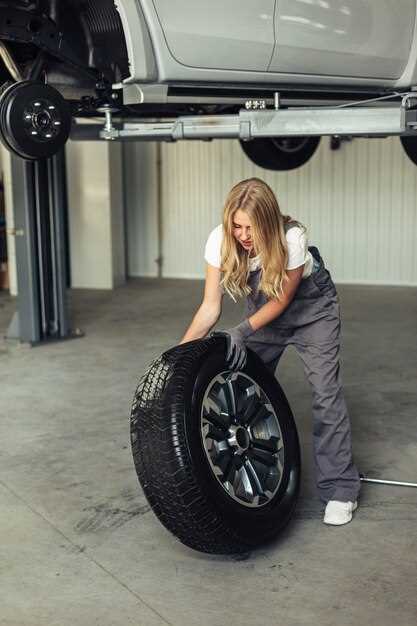How to Safely Stretch Tires for a Stanced Look


Tire stretching has become a popular trend among automotive enthusiasts looking to achieve a unique stanced aesthetic. This modification not only enhances the visual appeal of a vehicle but also can improve its handling dynamics when done correctly. However, it is crucial to approach tire stretching with caution to ensure safety and mechanical integrity.
In this article, we will explore the various techniques and considerations involved in safely stretching tires. From understanding the appropriate tire sizes to selecting the right wheels, each aspect plays a vital role in achieving the desired look without compromising performance or safety. Proper preparation and attention to detail are essential to ensure that your vehicle remains roadworthy while flaunting a stylish stance.
We will also discuss the potential risks associated with tire stretching, including the impact on handling, ride comfort, and tire longevity. By following our guidelines and maintaining a focus on safety, you can enjoy the benefits of a stanced aesthetic without sacrificing your vehicle’s performance or reliability. Get ready to learn the art of tire stretching, ensuring a perfect balance between style and safety.
Choosing the Right Tire Size for Stretching
Selecting the appropriate tire size is crucial for achieving a successful stretch without compromising safety and performance. The goal is to achieve the desired aesthetic while ensuring that the tire still functions correctly and maintains its structural integrity.
First, consider the width of both the wheel and the tire. A wider wheel allows for a more pronounced stretch, but it also means you need to carefully choose the tire width to avoid excessive bulging. Generally, a tire that is 20-30mm narrower than the wheel’s width is a typical guideline for stretching. For instance, if you have an 8-inch wide wheel, a 195 or 205 size tire might be an appropriate choice.
Profile aspect ratio is another critical factor. A lower profile tire can enhance the stretching effect, as it has less sidewall height. However, going too low can lead to a harsher ride and increased susceptibility to tire damage. A reasonable aspect ratio, like 35 or 40, balances aesthetics and comfort, providing a stretched look while retaining some sidewall height for flexibility.
It’s also essential to consider the intended use of the vehicle. If you plan to drive aggressively or on uneven surfaces, a smaller tire size may not provide the needed grip or comfort. In contrast, a more aggressive stretch can be suitable for show cars, which are frequently used for display rather than daily driving.
Lastly, ensure that the overall diameter of the tire remains within a safe range compared to the stock size. Drastic changes can affect vehicle dynamics, including steering response and traction. Aim for a minimal difference in diameter, ideally within 2% of the factory specifications, to maintain performance and safety standards.
Understanding the Risks of Tire Stretching
Tire stretching has become a popular modification in the car enthusiast community, particularly among those seeking a stanced aesthetic. However, it is essential to understand the associated risks before proceeding with this trend. One of the most significant risks is compromised safety. When tires are stretched, they may not maintain proper contact with the road, leading to reduced grip, especially in wet or slippery conditions. This can result in longer stopping distances and an increased likelihood of losing control.
Another concern involves tire wear and durability. Tires that are stretched can wear unevenly due to altered contact patches and stress distributions. This can lead to premature tire failure, resulting in blowouts while driving, which can be catastrophic. Moreover, stretched tires are more susceptible to sidewall damage, making them vulnerable to punctures and other forms of damage that could exacerbate safety issues.
The fitment of stretched tires can also affect suspension geometry and alignment. Incorrect alignment can lead to further tire wear and handling issues, impacting the overall performance of the vehicle. Additionally, modifications to achieve a stanced look may require changes to suspension components, which can increase wear on those parts as well.
Legal implications should also be considered. Some regions have specific regulations surrounding tire specifications and modifications. Using non-compliant tire sizes may result in fines or issues during vehicle inspections.
Ultimately, while tire stretching can enhance the visual appeal of a vehicle, it is crucial to weigh these risks carefully. Ensuring proper installation, maintaining an appropriate riding height, and choosing the right tire sizes can mitigate some dangers. However, enthusiasts should always prioritize safety and performance over aesthetics when making modifications to their vehicles.
Tools and Materials Needed for the Process

To safely stretch tires for a stanced aesthetic, you will need specific tools and materials to ensure a successful outcome while minimizing risks. Here’s a comprehensive list of what you need:
1. Tire Stretching Tools: A tire stretching machine or manual tire levers are essential for applying controlled forces to the tire. These tools help in evenly distributing tension without causing damage to the tire or rim.
2. Air Compressor: An air compressor is necessary for adjusting tire pressure during the stretching process. Maintaining the correct pressure is crucial for achieving the desired stretch while ensuring tire integrity.
3. Tire Installation Tools: Tire spoons or levers will assist in fitting the stretched tire onto the rim without pinching or damaging the sidewalls. Using these tools properly helps in preventing unnecessary wear on the tire.
4. Lubrication Solution: A tire lubricant can reduce friction during the installation process, making it easier to stretch the tire onto the rim. Recommended products include tire mounting fluid or soap-based solutions.
5. Pressure Gauge: A reliable pressure gauge is important for monitoring tire pressure throughout the stretching phase. Ensuring the right pressure will help maintain the shape and performance of the tire.
6. Measuring Tools: Calipers or rulers can help in accurately measuring the desired stretch and ensuring the tire fits correctly on the rim. Proper measurements are essential to achieve the right aesthetic without compromising safety.
7. Safety Equipment: Always wear safety glasses and gloves when working with tires and tools. Proper hand protection can prevent injuries, while safety glasses help protect against debris that might be released during the process.
8. Tire Bead Sealer (Optional): In some cases, using bead sealer can help secure the tire bead to the rim, especially if the stretch leads to potential sealing issues. This product adds an extra layer of assurance for tire integrity.
Gathering these tools and materials before starting the tire stretching process can help ensure a smooth and safe experience. Proper preparation reduces the risk of damaging your tires or risking your safety on the road.
Step-by-Step Guide to Stretching Tires
Stretching tires requires careful planning and execution to ensure safety and aesthetics. Follow these steps for a successful tire stretching process:
| Step | Description |
|---|---|
| 1. Choose the Right Tires and Wheels | Select tires that are compatible with your desired wheel width. Research sizes and fitments for the best results. |
| 2. Gather Necessary Tools | Prepare tools such as a tire machine, tire levers, soapy water, air compressor, and wheel weights. |
| 3. Remove the Tires from the Wheels | Carefully use a tire machine or levers to dismount the existing tires without damaging the wheels. |
| 4. Mount the New Tires | Install the new tires on the wheels, ensuring they are seated properly. Use soapy water to help ease the process. |
| 5. Inflate Gradually | Inflate the tires slowly. Monitor the tire’s bead seating as air is added. Check for any leaks or uneven seating. |
| 6. Check Alignment | Once mounted, check that the tires are aligned correctly with the wheels. Adjust if necessary to achieve even stretching. |
| 7. Conduct Safety Checks | Before taking the vehicle on the road, inspect the tire installation for any signs of improper seating or damage. |
| 8. Drive Cautiously | Test drive the vehicle at low speeds. Monitor tire performance and listen for any unusual sounds that could indicate problems. |
Following these steps systematically ensures a safe and aesthetically pleasing tire stretch while minimizing risks associated with improper installations.
Inspecting and Maintaining Stretched Tires
Regular inspection of stretched tires is crucial for ensuring safety and performance. Start by checking the tire pressure, as over-inflation or under-inflation can lead to uneven wear or damage. Maintain the recommended pressure levels specified by the tire manufacturer, as stretched tires can behave differently than standard ones.
Next, visually inspect the sidewalls for signs of cracking or bulging. Stretching tires can sometimes lead to stress on the rubber, so any visible imperfections should be taken seriously. If you notice any irregularities, consider replacing the tire to prevent potential blowouts.
Pay close attention to the tread depth. Stretched tires may wear unevenly, especially on the inner edges. Use a tread depth gauge to measure the depth and ensure it meets safety standards. If the tread is too shallow, it’s time for a replacement to maintain traction and control.
Furthermore, perform a monthly inspection of the bead area where the tire meets the rim. This zone is critical, especially for stretched setups. Look for any separation or air loss issues that could arise from improper installation or excessive stress on the tire.
Maintaining proper alignment is essential, as misalignment can exacerbate uneven wear on stretched tires. Regularly check your vehicle’s alignment and make adjustments as needed to ensure even tire wear and optimal handling.
Rotate your tires regularly following the manufacturer’s recommendations. This practice helps distribute wear more evenly across all tires, prolonging their life and maintaining performance. Keep track of the rotation schedule in case adjustments or replacements are necessary over time.
Finally, consider protecting your tires from harsh environmental conditions. UV rays, road debris, and harsh chemicals can degrade rubber over time. Using tire covers when the vehicle is parked for extended periods can help preserve their longevity, while regular cleaning with appropriate products will keep them in good condition.
Legal and Safety Considerations for Stanced Cars
When modifying a vehicle for a stanced aesthetic, it is crucial to understand the legal and safety implications involved in such alterations. Below are key considerations to ensure compliance and protection while achieving the desired look.
-
Local Laws and Regulations
- Check for specific laws regarding vehicle modifications in your area.
- Be aware of regulations surrounding tire width and wheel offsets.
- Ensure that your vehicle adheres to vehicle height regulations to avoid penalties.
-
Insurance Implications
- Notify your insurance provider about any modifications to your vehicle.
- Understand how modifications can affect your coverage and premiums.
- Consider additional coverage for specialized parts or potential damages.
-
Safety Considerations
- Maintain adequate tire pressure to prevent blowouts or handling issues.
- Ensure that suspension modifications do not compromise ride quality and stability.
- Regularly inspect suspension components for wear and tear due to altered geometry.
-
Performance Impact
- Understand that extreme stancing may affect brake performance.
- Monitor tire wear patterns; uneven wear can indicate safety concerns.
- Be mindful of how altered camber angles can impact handling and traction.
-
Community & Event Participation
- Research requirements for participating in car meets or events.
- Engage with communities that share interest in stanced cars for advice and support.
- Consider forming or joining clubs that promote safe practices in car modifications.
By understanding and addressing these legal and safety considerations, you can enjoy your stanced vehicle while minimizing risks and ensuring compliance with applicable laws. Always prioritize safety and legality in your modifications to create a responsible car culture.
